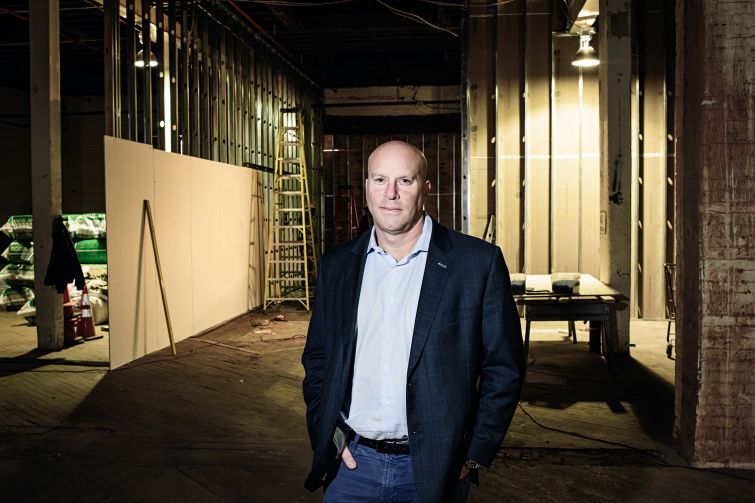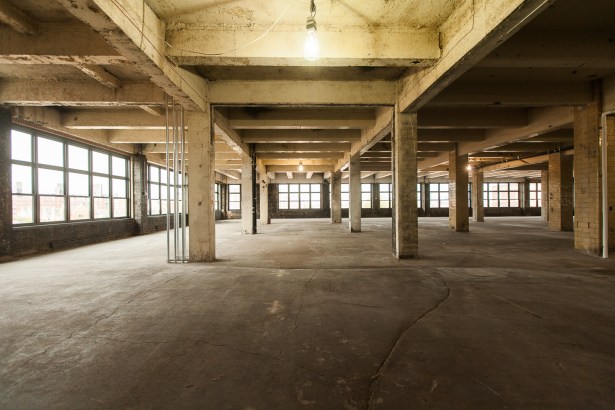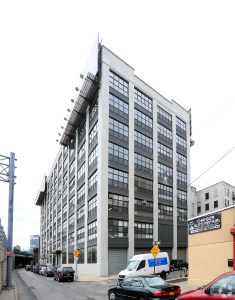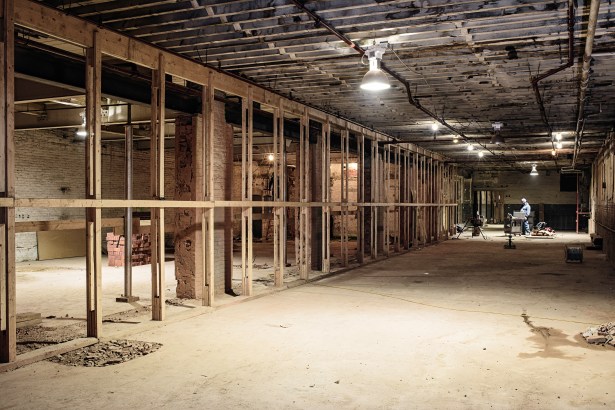Why Developer Daren Hornig Is Taking a Chance on Outer Borough Office Projects
By Rebecca Baird-Remba January 3, 2018 12:52 pm
reprints
Daren Hornig has taken some big bets on up-and-coming office markets in Brooklyn and the Bronx. Despite some major financial hurdles, office tenants are starting to flock to what used to be sleepy industrial zones in the outer boroughs, and Hornig’s bets are paying off.
At the former Schlitz Brewery at 95 Evergreen Avenue in Bushwick, Brooklyn, his four-and-a-half-year-old Great Neck, N.Y.-based firm Hornig Capital Partners successfully leased the entire 165,000-square-foot office conversion to the city’s Human Resources Administration last September. He teamed up with Savanna to purchase the building in January 2015 for $33.7 million and shelled out another $30 million revamping it in 2016.
Then Hornig, a former office broker with a nose for what tenants want, decided to take a gamble on investing three stops farther east along the L train. With the help of its development partner, the Brickman Group, Hornig Capital Partners purchased a former packaging plant at 1519 Decatur Street, along the Bushwick-Ridgewood border, in May 2016 for $10.2 million. After a $10 million renovation that included new windows, mechanicals and bathrooms, the 63,000-square-foot “Box Factory” is ready for creative, Brooklyn-dwelling tenants.
But Brooklyn isn’t Hornig’s only focus. He’s taken the plunge in the South Bronx, too. In March 2015, Savanna and HCP partnered to purchase a hulking, eight-story warehouse at 2417 Third Avenue in the South Bronx for $30.6 million. Since being revamped as the “Bruckner Building” in honor of its location by the bustling Bruckner Boulevard, the once-abandoned 172,000-square-foot loft building is slowly filling up with a mix of industrial businesses, tech companies and artists.
The 50-year-old Bellmore, N.Y., native and married father of 17-year-old twins recently sat down with Commercial Observer to talk about his residential and commercial projects, his seven-year stint as an office leasing broker at Newmark, now Newmark Knight Frank, and his ties to Entourage creator Doug Ellin.
Commercial Observer: Tell us about your newest project, the Box Factory.
Daren Hornig: It’s literally on the corner of Irving and Decatur. That block divides Ridgewood and Bushwick. So we tried to rename the area “Ridgewick,” and it didn’t go as well as Tribeca, Nolita and every other neighborhood. It’s a high-end conversion of a warehouse for office and retail. So we’re talking to a bunch of tenants from that area, and it’s a block and a half from the Halsey [Street] L [station].

What sort of tenants are you looking to bring in there?
TAMI [or technology, advertising, media and information] tenants. Tech, arts, media, a bunch of makers. Two breweries have taken a look recently, and a coworking firm has expressed interest for the property.
We’re taking a contrarian approach on the L train that not everything is doom and gloom. There are millions of people who live in Brooklyn and Queens that will commute west to east and take the L train to neighborhoods [where they work]…We’ve seen a tremendous amount of tenant interest from people who live in Williamsburg and Bushwick that don’t want to have to go into Manhattan, and they’re actually turning around. They’ll use the L train because it’s still going to operate in Brooklyn.
How’s everything going at the Bruckner Building?
We’re really renovating the entire property from top to bottom. Put a new roof on, new windows, repainted the entire building, renovated all the floors. So it’s in lease-up mode. It was 100 percent leased when we bought it, and now we’ve taken it down to 40 percent because a lot of people were illegally living in there. But the Bronx is hot. There’s a tremendous amount of activity going on. There’s a lot of new development—Keith Rubenstein and [his] Somerset [Partners] are developing a tremendous amount of residential around us. The old History [Channel] building supposedly has a lease signed for the entire building. The Clock Tower building that exists presently on Bruckner—[the owner, Carnegie Management] built two [residential] additions there, and they’re in lease-up mode. The rents are going to be in the high $40s, low $50s per foot, which is a very strong rent for that market.
You said the Bruckner Building is 40 percent leased. What sort of tenants do you have in there right now?
There’s a nice array of different tenants from artists to makers to manufacturers, a few tech companies. There are sound studios in there. A company called Duro just moved in recently that does drones. Bronx Edible is moving in. Keith from Somerset is moving his office from glorious Park Avenue uptown [into the Bruckner Building].
There are some sculptors, paint canvas artists, a furniture manufacturer and a fabricator in there. So there’s a good eclectic mix of tenants, with spaces as small as 1,000 feet and a full floor of 22,000 square feet.
What made you decide to invest in the commercial markets in Bushwick and the South Bronx?
It was a combination of things. [With] Manhattan being very expensive and very competitive, I started looking at alternative markets. When I started my company four and a half years ago, the first thing I actually bought was in an extensively alternative market—Cleveland, Ohio—I bought a shopping center there. But being a New York guy and having strong relationships and knowing Brooklyn and knowing the Bronx, it’s a lot easier to get around here, and there’s a lot more demand. I was looking for that unique type of building that had high ceilings, felt lofty, the à-la-Midtown South genre of buildings. And Bushwick was getting very hot. I was on a few deals in Williamsburg, and then the market tanked in ‘08, ‘09. And then the market started to move and shift toward Bushwick. Similarly we were looking at what else was happening and made a similar purchase in the Bronx [with] the Bruckner Building.
I think today [for] tenants and people individually, it almost doesn’t matter where you work. But they want to be in a creative and dynamic environment that enables them to really focus on their creativity and lets them be who they are.
What was it like getting financing for these projects?
Challenging. The debt markets are strong on cash-flowing assets and properties that you can easily comp out [find comparable properties]. So it’s easy to go up and down Park Avenue and Fifth Avenue and show thousands of leases that were done in the last few years and pricing. When you go to these emerging markets, it’s a lot more challenging to find significant comps of what tenants have paid in rent. It’s a lot more handholding, a lot more of an education and getting [the lenders] comfortable with the pricing and the vision. It wasn’t easy with either property, but at the end of the day, we proved what the value was. And obviously now at [95] Evergreen [Avenue in Bushwick], the lender is extremely happy to have the city with AA credit taking over the lease for 20 years.
I’ve heard the Bruckner Building was in pretty rough shape when you bought it. Tell us more about the condition when you first purchased it.

The previous owner had owned it for 30 years. And I don’t think he put more than $10,000 into the building. And it was a complete mess. It only had one elevator operational at the time. The other one was completely decommissioned.
We had to open up the lobby, we installed an ADA ramp and ADA access to the lobby, put a new storefront on, replaced over 100 windows throughout the property and really cleaned it up significantly. The roof was completely saturated and had some asbestos in it. So we abated it and put a brand new roof on.
I’m a big believer, as is the Savanna team, that you have to make the investment and show your tenants that you’re willing to make the investment to attract them. A lot of people will buy buildings and then wait for the tenant.
It may be a more conservative approach, but it’s very difficult to attract the tenants. Especially when you see what’s going on in Williamsburg and Bushwick, [landlords] don’t do any work to their buildings. They’ll get a lease, and there’s no tenancy because they don’t fulfill the work letter or what’s expected of them.
Are you talking about landlords doing office conversions?
Anything—office, retail. You drive through Bushwick, it’s still very, very industrial. There have been a lot of purchase and a lot of hype, but nothing has gotten over that second gear yet.
There were a couple of those office conversions near the Morgan and Jefferson L stops, but none of it really seems to be happening yet.
There’s [Rabsky Group’s portion of the] Rheingold [Brewery] development, which is almost done. I think they’re going to start tenancy early next year.
But that’s mostly residential.
It’s a combination. Real estate, and real estate development, is really a chicken-and-egg game. If you build commercial, people don’t necessarily want to go there because they don’t live nearby. But if you have residential and people live there, they will then say, “You know what, I don’t need to go to Manhattan to work. I’ll work in Bushwick.” I think the residential and having thousands of people move in there will help foster the commercial over time. You get 2,000 people living there, you get people visiting. That creates more traffic, and the retail environment heats up because people need to eat drink and shop.
What do you feel like is the next up-and-coming office market in the five boroughs? And where are you looking to invest next?
I think along the waterfront, five-borough-wise, or four-borough, still [excluding Staten Island]. I think the South Bronx is hot, and it’s going to stay hot. Especially once Somerset breaks ground and starts building out their location. L+M [Development Partners] just did a large deal in the South Bronx where they’re putting the Hip-Hop Museum. So I think the South Bronx is going to continue to stay strong because of its proximity and transportation and relative transportation to the rest of New York City.
And I’ve been saying Long Island City [Queens] for 20 years. It’s definitely achieved the critical mass of residential. It’s rumored that there are almost 20,000 units coming online in rental. Is there too much supply coming online in that market? There will be interesting supply and demand dynamics that will play themselves out.
But office there is a great market. [Office tenants] are renting in Long Island City, and large deals are getting done there. People want to pay $40, maybe $50 a foot in the Long Island City market [to rent office space].
What’s going on with your 48-unit condo project at 211 Schermerhorn Street in Boerum Hill, Brooklyn?
It’s in development. We’ve finished foundations, and we’re coming out of the ground. The sales center is open at 333 Atlantic Avenue. That’s a partnership we have with GPB Capital [Holdings] and Oestreicher Properties. And sales are going nicely. Looks great, and we’ve gotten good press on it.
What about your big affordable residential development at St. Barnabas Hospital in the Belmont area of the Bronx?
St. Barnabas is under construction. We’re about halfway done. The facade was just put on the south building. Looks great. That’s a deal we have in partnership with L+M. And that’s one of those deals that feels good, and obviously we make a living, but obviously it’s nice that we’re giving back to the community. It’s by and large an affordable housing project that we took a special element of consideration and made it one of the first, if not only, health care-integrated affordable housing projects. So it’s going to have a 50,000-square-foot ambulatory care facility in the base. Everything we’re doing there is geared toward health and the wellbeing of the community and the citizens. We’re putting bacteria-free paint on and putting special equipment in to try and deflect the asthma that’s prevalent in the Bronx.
The nicest component we’re doing is that we’re putting a rooftop farm on the building where the community can grow fresh vegetables. And in conjunction with St. Barnabas Hospital, we’re creating a teaching kitchen within the retail space of the building where we’re going to teach the parents of the community how to cook and prepare healthy meals.

You got your start doing office leasing, right? And you worked with a lot of internet companies?
So I started out as an office-leasing broker with Newmark. I was lucky to have great mentorship there with Barry Gosin and Billy Cohen. At that point I was representing a lot of technology companies. The internet was like a foreign object back then, and no one really knew what it was.
I did a lot of research and found that 99 percent of the buildings in New York City did not have the right fiber optic infrastructure to support broadband communications for the future. So [in 1997], I started a company, Onsite Access. And Scott Rechler from RXR [Realty] backed me on that company. And we created one of the largest broadband communications companies in the United States. We had agreements and contracts with 750 buildings and about 350 million square feet to expand throughout the country. Unfortunately, the dot-com bubble burst, and it obviously affected us and everyone else. But the vision was right, and I was unfortunately years before my time. But I think that’s one of the challenges and one of the things you learn in this business.
And from there you transitioned out of being a broker. You went into the construction industry, and then you sort of made your way into development that way?
Yes. So I joined a group [VVA] where I did some project management. So I understood the construction side. Then I bought a [residential brokerage] company called Dwelling Quest. I sold Dwelling Quest to Century 21 in 2006. And then I was on my way to being a developer. That was about 15 years ago. [From then until founding his own firm, Hornig was a partner and ran the northeast division for a Scottsdale, Ariz.-based development firm called Saxa. He was also briefly a partner at Metropolitan Realty.]
If I remember correctly, you grew up with the creator of Entourage?
Yes, I grew up with the creator, Doug Ellin. But truth be told, he was better friends with my wife; they were both a year younger than me in high school. And he name-dropped me in an episode. Even though I’ve done hundreds of millions of dollars in deals across this great country, my claim to fame is being mentioned on Entourage.


